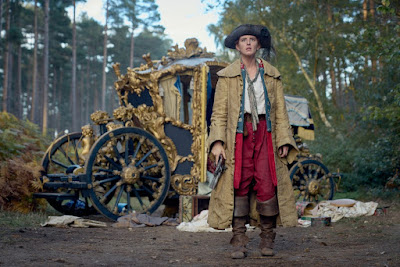Prince Valiant (1954) is a fairly faithful adaptation of the venerable comic strip by Hal Foster, Prince Valiant in the Days of King Arthur. As in the comic strip, historical verisimilitude is strained by a plethora of anachronisms (the coexistence of 5th century Britons and 9th-11th century Vikings being one example), but if one can excuse the liberties taken with reality (as any fan of the comic strip surely can), then one is free to enjoy the rollicking adventure that is the film.
The titular protagonist (played by Robert Wagner) is the heir to the throne of a fictional Christian kingdom in Scandinavia. The throne, however, has been usurped, and the royal family, having been granted the protection of King Arthur, now resides in a secret location in Britain. Much of the plot involves Valiant's passage to knighthood, his efforts to restore his father to the throne, and the awakening of his love for the Princess Aleta (Janet Leigh).
On the whole, it is moderately well acted for a moderately well written screenplay, with the exception of James Mason, who gives a creditable performance as the villain, and Sterling Hayden, who gives an explosively bad performance as Valiant's mentor, Sir Gawain. The prevalence of American accents in a tale set in mythical Britain may be a mild, but not insurmountable, distraction. Hayden's interpretation of Sir Gawain as a U.S. Marshall in the Old West, however, is howlingly atrocious to the point of hilarity. Was Hayden even trying to act, or was the resultant comedy deliberate? Did the director, Henry Hathaway, realize that Hayden had been miscast and just told him to do his best, or did he say, "Pretend you're a cowboy. It will be hilarious!"
Hayden's colossal ineptitude in the role does not, thankfully, destroy the entire picture. The production values and cinematography are well above average, the pacing is good, and the stunts are plentiful. The jousting scenes are very well executed, the castle siege is an amazing feat of large scale fight choreography depicting many of the aspects of siege warfare, and the climactic trial by combat with swords and shields is truly the highpoint of the film.
If one can forgive the clichés and Hayden's infractions against the acting profession, one will find Prince Valiant to be a vigorous and entertaining action movie.
Writing: Fair
Directing: Fair
Acting: Mediocre (Sterling Hayden: Terrible; James Mason: Good)
Cinematography: Good
Stunts: Great
Swordplay: Great
Panache: Fair
Overall Rating: Good
Swashbuckling Rank: Good
[Originally posted in Cuparius.com on 27 January 2012.]
Addendum
Written by: Dudley Nichols
Based on:
Prince Valiant in the Days of King Arthur by Hal Foster
Directed by: Henry Hathaway
Performed by: James Mason, Janet Leigh, Robert Wagner, Debra Paget, Sterling Hayden, et al.




